Étienne Adolphe Piot stands as a significant, if sometimes overlooked, figure in nineteenth-century French art. Renowned primarily for his elegant and sensitive portrayals of young women, Piot's work captures the essence of an era, blending academic precision with a subtle, almost tender, observation of his subjects. His career spanned a dynamic period in art history, witnessing the dominance of Academic art, the rise of Impressionism, and the flourishing of the Belle Époque.
Navigating the precise details of Piot's life presents certain challenges, as historical records occasionally offer conflicting information regarding his birth year. While the most widely accepted and corroborated dates place his birth in 1831 and his death in 1910, some sources have suggested alternative birth years, including 1825 or, less commonly, 1850. Similarly, a minority of accounts mention 1909 as his year of death. However, for the purpose of art historical consensus, the 1831-1910 timeframe is generally preferred and aligns with the known trajectory of his career and exhibition history.
Early Life and Artistic Formation
Born in Digoin, Saône-et-Loire, France, Étienne Adolphe Piot's artistic journey began under the tutelage of one of the era's most respected academic painters, Léon Cogniet. Cogniet, a prominent figure at the École des Beaux-Arts in Paris, was known for his historical paintings and portraits, and his studio attracted numerous aspiring artists. Under Cogniet's guidance, Piot would have received rigorous training in drawing, composition, and the classical techniques that formed the bedrock of academic art.
This traditional artistic education emphasized anatomical accuracy, a smooth, polished finish, and the depiction of idealized forms, often drawn from classical antiquity or historical narratives. Cogniet himself was a student of Pierre-Narcisse Guérin, linking Piot to a lineage of French Neoclassical and Romantic painters. Other notable artists who studied with Cogniet, or were his contemporaries and products of a similar academic system, include Jean-Louis-Ernest Meissonier, known for his meticulous historical genre scenes, and Rosa Bonheur, celebrated for her animal paintings. This foundational training profoundly shaped Piot's approach to portraiture, instilling in him a respect for craftsmanship and a pursuit of refined beauty.
Debut at the Paris Salon and Rising Reputation
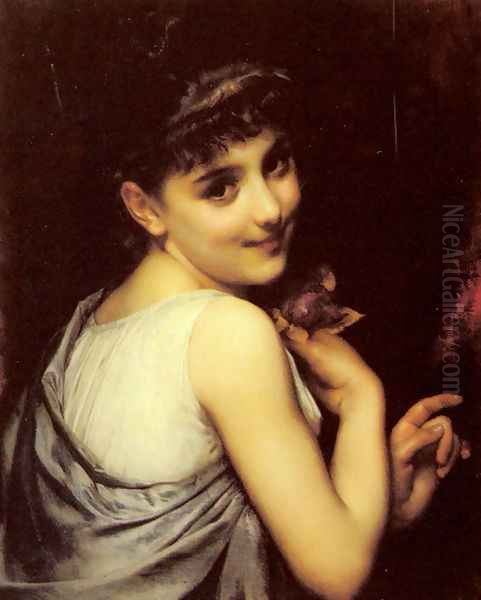
The Paris Salon, the official art exhibition of the Académie des Beaux-Arts, was the most important venue for artists in France to display their work and gain recognition. Making a successful debut at the Salon could launch an artist's career, leading to commissions, critical acclaim, and sales. Piot made his first appearance at the Paris Salon in 1850, marking his official entry into the competitive Parisian art world.
His early submissions likely consisted of portraits, the genre that would come to define his oeuvre. Throughout the subsequent decades, Piot became a regular exhibitor at the Salon, consistently presenting works that appealed to the tastes of the time. His ability to capture not just a likeness but also an air of grace and introspection in his sitters earned him a steady stream of patrons, particularly from the affluent bourgeoisie who sought to immortalize themselves and their families in paint. The Salon was a crowded field, featuring works by giants of Academic art like William-Adolphe Bouguereau, Alexandre Cabanel, and Jean-Léon Gérôme, whose grand historical, mythological, and orientalist scenes often dominated the exhibitions. Piot carved his niche by focusing on more intimate, though no less idealized, portrayals.
Artistic Style and Thematic Focus
Piot's artistic style is firmly rooted in the academic tradition, characterized by meticulous draftsmanship, smooth brushwork that conceals the artist's hand, and a careful modeling of form to create a sense of three-dimensionality. He possessed a remarkable ability to render textures, from the softness of skin and the sheen of hair to the intricate details of fabric and lace. His palette was often rich yet controlled, employing subtle gradations of color to achieve lifelike effects.
While technically an academic painter, some of Piot's works, particularly in their handling of light and atmosphere, show a sensitivity that might hint at an awareness of, if not direct engagement with, the burgeoning Impressionist movement. However, unlike Impressionists such as Claude Monet or Pierre-Auguste Renoir, who sought to capture fleeting moments and the effects of light with visible brushstrokes, Piot maintained a commitment to a more polished and idealized representation.
His primary thematic focus was the young woman, often depicted in bust-length or half-length portraits. These were not always commissioned works in the strictest sense; many were idealized "fancy pictures" or "tronies" – studies of expression or character – that showcased feminine beauty, innocence, and contemplation. His subjects are typically portrayed with a gentle, sometimes melancholic, expression, their gaze often averted or directed softly towards the viewer, creating an intimate connection.
Representative Works and Their Qualities
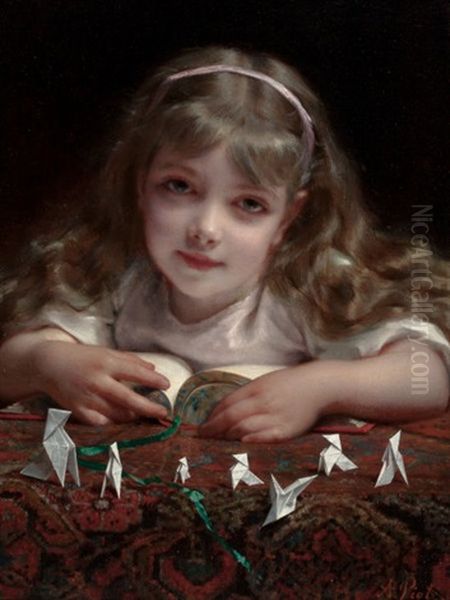
Several paintings stand out as representative of Étienne Adolphe Piot's artistic output and thematic preoccupations. While specific titles can vary or be generic, works commonly attributed to him often feature descriptive titles that highlight the subject's activity or a prominent feature.
A Reading Girl (Jeune fille lisant): This subject, a young woman absorbed in a book, was a popular motif in 19th-century art, symbolizing education, introspection, and quiet domesticity. Piot's renditions typically emphasize the sitter's delicate features, the soft fall of light on her face and hair, and the serene atmosphere of the scene.
Girl with Roses (Jeune fille aux roses) or A Young Beauty Holding a Red Rose: Flowers, particularly roses, were frequently used in portraiture to symbolize beauty, youth, love, or transience. In Piot's hands, a young woman holding a rose becomes an emblem of blossoming femininity and delicate charm. The contrast between the soft petals of the rose and the sitter's skin would have allowed him to showcase his skill in rendering different textures.
Portrait of a Young Girl (Portrait de jeune fille): This title encompasses many of his works. A notable example dated around 1850 would demonstrate his early mastery of the academic style. These portraits are characterized by their smooth finish, idealized features, and often a dark, neutral background that makes the sitter's face and attire stand out. The lighting is typically carefully managed to highlight the contours of the face and create a soft, luminous effect.
Mother (Mère): While less common than his portrayals of solitary young women, depictions of motherhood would have allowed Piot to explore themes of tenderness and familial bonds, still within his preferred aesthetic of grace and idealized beauty.
Origami Dreams: This title suggests a more imaginative or allegorical subject, perhaps a later work or one that incorporates symbolic elements beyond straightforward portraiture. The theme of dreams or reverie aligns well with the often contemplative mood of his figures.
Across these and other works, Piot consistently demonstrated a refined sensibility. His young women are rarely depicted with overt drama or strong emotion; instead, they exude a quiet elegance and an inner life that invites the viewer's contemplation. The clothing is often fashionable yet timeless, contributing to the idealized and somewhat romanticized vision of femininity that was popular during the Belle Époque.
The Parisian Art Scene and Contemporaries
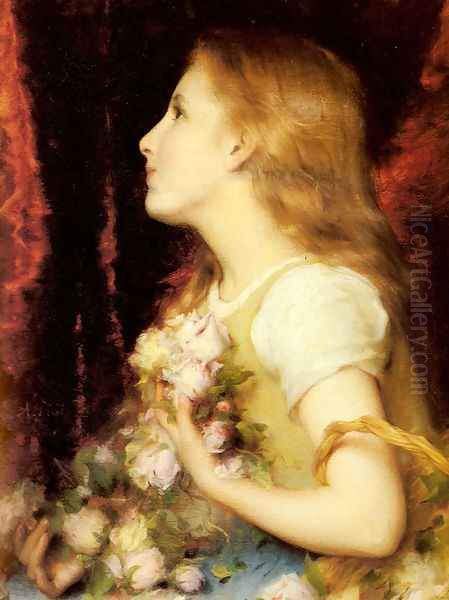
The latter half of the 19th century in Paris was a period of immense artistic ferment. While Piot operated within the established academic system, this system was increasingly being challenged by avant-garde movements. The Impressionists, including Claude Monet, Edgar Degas, Camille Pissarro, and Berthe Morisot, began exhibiting independently in the 1870s, advocating for painting en plein air, capturing subjective visual impressions, and using looser brushwork and brighter palettes.
Piot's adherence to academic principles placed him in the company of artists who continued to uphold the traditional values of the Salon. Figures like William-Adolphe Bouguereau were immensely popular, creating highly polished mythological and genre scenes. Alexandre Cabanel, another Salon favorite, was renowned for works like "The Birth of Venus," which epitomized the academic ideal of beauty. Jean-Léon Gérôme excelled in historical and Orientalist subjects, rendered with photographic precision.
While Piot's subject matter was more intimate than the grand narratives of these artists, he shared their commitment to technical skill and idealized representation. His focus on female portraiture also aligns him with other successful portraitists of the era, though his style differed. For instance, society portraitists like John Singer Sargent (an American who worked extensively in Paris and London) and Giovanni Boldini (an Italian active in Paris) captured the glamour and dynamism of their sitters with a more flamboyant and bravura technique. Piot’s approach was generally more subdued and introspective.
Even within the academic sphere, there was diversity. Léon Bonnat, for example, was a highly sought-after portraitist known for his robust realism, a contrast to Piot's more delicate idealization. The Realist movement, championed earlier by Gustave Courbet and Jean-François Millet, had also left its mark, emphasizing the depiction of ordinary people and everyday life, though this was not Piot's primary concern. Piot's art, therefore, existed within a complex ecosystem, maintaining a popular appeal for its charm and technical finesse amidst a rapidly evolving artistic landscape.
International Recognition and Continued Activity
Piot's reputation was not confined solely to France. In 1864, he exhibited a portrait at the National Academy of Design in New York, indicating an ambition to reach an American audience. This was not uncommon for successful European artists of the period, as the United States, with its growing class of wealthy industrialists, represented a significant market for art.
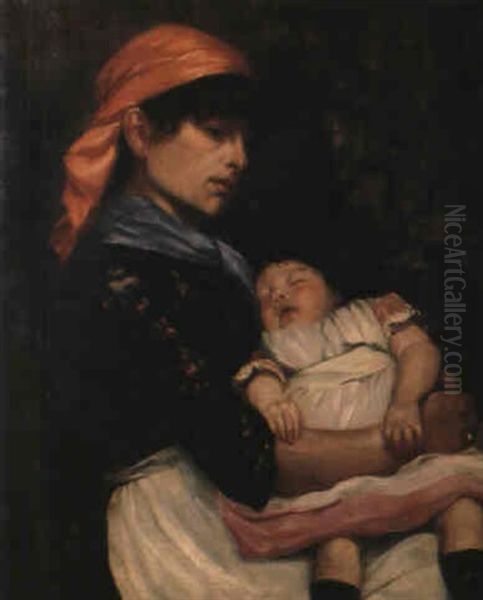
He continued to be an active participant in the Parisian art scene. In 1883, he became a member of the Société des Artistes Français, the organization that took over the running of the annual Salon after the French government relinquished control. This membership signified his established position within the artistic community. His consistent participation in exhibitions, including a notable recognition at the Bordeaux exhibition in 1860, underscores his sustained productivity and the continued demand for his work.
A significant accolade came later in his career when he received an honorable mention or medal for a work exhibited at the Exposition Universelle (World's Fair) of 1889 in Paris, an award formally recognized in 1890. These grand international expositions were major cultural events, and recognition at such a venue was a prestigious achievement, further cementing his status.
The "Protestant Newfoundland Dog": An Enduring Anecdote
Beyond his artistic endeavors, a curious and humane anecdote is often associated with Étienne Adolphe Piot, lending a unique dimension to his biography. It is recounted that Piot was an avid fisherman and frequently spent time angling from the bridges of the Seine River in Paris. During this era, the Seine was tragically a common site for suicide attempts.
According to these accounts, Piot, on multiple occasions, intervened to save individuals who had jumped into the river. His repeated acts of bravery and compassion earned him the rather unusual nickname "le terre-neuve des protestants" or "the Protestant Newfoundland dog." The "Newfoundland dog" part of the moniker clearly refers to the breed's reputation as a rescue dog, particularly in water. The "Protestant" qualifier is more obscure; it might relate to the individuals he rescued, or perhaps it was a colloquialism of the time whose specific meaning is now lost. Regardless of the exact origins of the full nickname, this story paints a picture of Piot as a man of courage and empathy, extending his sensitivity beyond the canvas into real-life heroism.
Later Career, Legacy, and Collections
Piot continued to paint and exhibit into the early 20th century. His style, while refined, remained largely consistent with the academic principles he had mastered early in his career. This meant that as artistic tastes evolved dramatically with the advent of Post-Impressionism, Fauvism, and Cubism, Piot's work might have appeared increasingly traditional to the avant-garde. However, for a segment of the public and art collectors, the charm, elegance, and technical skill of his portraits retained their appeal.
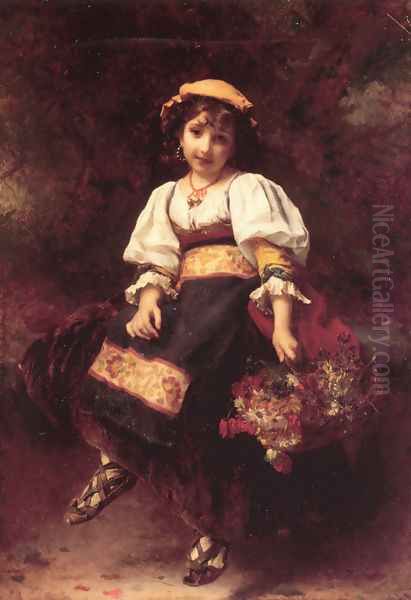
His death in 1910 marked the end of a long and productive career dedicated to capturing a particular vision of feminine beauty. Today, Étienne Adolphe Piot's paintings are held in various public and private collections. Notably, the Musée des Beaux-Arts de Rouen in France and the Brooklyn Museum in New York are among the public institutions that house examples of his work. His paintings also appear periodically on the art market, where they continue to be appreciated for their decorative qualities and their evocation of the Belle Époque.
The legacy of Piot is that of a skilled and sensitive practitioner of academic portraiture. While he may not have been an innovator in the mold of the Impressionists or later modernists, he excelled within his chosen genre, creating images of enduring charm. His work serves as a valuable window into the aesthetic preferences and social aspirations of a significant portion of 19th-century society. Artists like Piot played a crucial role in the artistic ecosystem of their time, fulfilling a demand for beautifully crafted images that celebrated grace, youth, and an idealized vision of humanity.
Conclusion: An Artist of Grace and Subtlety
Étienne Adolphe Piot navigated the vibrant and often tumultuous art world of 19th-century Paris with a steadfast commitment to his craft. As a student of Léon Cogniet, he was thoroughly grounded in the academic tradition, which he skillfully adapted to his preferred subject: the portraiture of young women. His works are characterized by their delicate execution, sensitive portrayal of character, and an idealized beauty that resonated with the tastes of the Belle Époque.
From his debut at the Paris Salon in 1850 through decades of consistent exhibition and recognition, including an honorable mention at the Exposition Universelle of 1889, Piot established himself as a respected figure. His paintings, such as A Reading Girl and Girl with Roses, exemplify his ability to capture moments of quiet contemplation and innocent charm. Beyond his artistic achievements, the intriguing anecdote of his life-saving efforts on the Seine adds a layer of human interest to his biography.
While the art world underwent radical transformations during his lifetime with the rise of artists like Monet, Degas, Van Gogh, and Cézanne, Piot remained a dedicated exponent of a more traditional aesthetic. His paintings offer a serene counterpoint to the dynamism of modernism, providing a glimpse into a world that valued polish, grace, and the timeless allure of idealized femininity. Today, his works continue to be admired for their technical mastery and their gentle, evocative power, securing Étienne Adolphe Piot's place as a notable painter of his era.